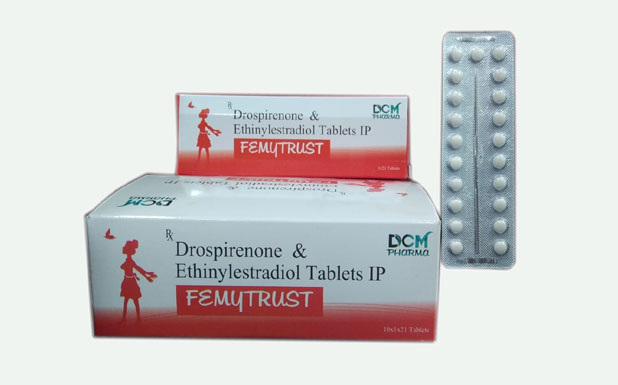
Composition
- Each film coated tablet contains:
- Drospirenone IP 3 mg
- Ethinylestradiol IP 0.03 mg
Packing
- 30 Tab
Bottle
MRP
- 256
Overview
Drospirenone and ethinyl estradiol combination is used to prevent pregnancy. It is a birth control pill that contains two types of hormones, drospirenone and ethinyl estradiol, and when taken properly, prevents pregnancy. It works by stopping a woman's egg from fully developing each month. The egg can no longer accept a sperm and fertilization (pregnancy) is prevented.
Indications
- Prevention of Pregnancy
- Postmenopausal Osteoporosis (PMO)
- Hypermenorrhea
- Endometriosis
Mechanism of Action
Ethinylestradiol is a synthetic estrogen that decreases luteinizing hormone to decrease endometrial vascularization, and decreases gonadotrophic hormone to prevent ovulation. It has a long duration of action as it is taken once daily, and a wide therapeutic index as overdoses are generally not associated with serious adverse effects. Combined oral contraceptives suppress ovulation by suppressing gonadotrophic hormone, thickening cervical mucus to prevent the travel of sperm, and preventing changes in the endometrium required for implantation of a fertilized egg. Ethinylestradiol decreases luteinizing hormone, decreasing vascularity in the endometrium. It also increases sex hormone binding globulin.
Absorption:
A 30µg oral dose of ethinylestradiol reaches a Cmax of 74.1±35.6pg/mL, with a Tmax of 1.5±0.5h
Protein binding:
Enthinylestradiol is 98.3-98.5% bound to albumin in serum8 but also exhibits binding to sex hormone binding globulin.
Metabolism:
Drug undergoes glcouridination, sulfation and hydroxylation. Hydroxylated metabolites can be methylated by catechol-O-methyltransferase. The methoxy metabolites can in turn be sulfated or glucuronidated.
Elimination:
Ethinylestradiol is 59.2% eliminated in the urine and bile, while 2-3% is eliminated in the feces. Over 90% of ethinylestradiol is eliminated as the unchanged parent drug. A 30µg oral dose has a half-life of 8.4±4.8h.
Drospirenone inhibits the maturation of follicles and inhibits ovulation, preventing pregnancy. It has antiandrogen effects, improving acne and hirsutism. When combined with ethinyl estradiol, it has been shown to have favorable effects on the plasma lipid profile. Due to its similarity to naturally occurring progesterone, drospirenone is thought to be associated with a lower incidence of progesterone contraceptive related adverse effects, such as breast tenderness and mood swings.
Absorption:
The absolute bioavailability of drospirenone is approximately 76% due to first-pass effects. The maximum plasma concentration of drospirenone occurs within 1 to 2 hours after oral administration.
Volume of distribution:
The volume of distribution of drospirenone is estimated to be 4 L/kg
Protein binding:
Drospirenone is about 95% to 97% bound to serum plasma protein, likely to albumin.
Metabolism:
Drospirenone also undergoes oxidative metabolism via the hepatic cytochrome enzyme CYP3A4.
Route of elimination:
Various metabolites of drospirenone are measured in the urine and feces.
Between 38% to 47% of the metabolites are identified as glucuronide and sulfate conjugates in the urine.
In the feces, approximately 17% to 20% of identifiable metabolites are found to be excreted as glucuronides and sulfates.
The serum half-life of drospirenone is estimated to be 30 hours. The half-life of drospirenone metabolite excretion in the urine and feces is approximately 40 hours.
Side Effects
Common side effects include nausea, vomiting, headache, abdominal cramps/bloating, breast tenderness, swelling of the ankles/feet (retaining fluid), or weight change may occur. If any of these effects persist or worsen, tell your doctor or pharmacist promptly. Many women will not have regular periods while taking this medication.
Contraindication
The drug should not be used in following conditions:
- Breast cancer
- A condition with low thyroid hormone level
- Diabetes
- High cholesterol
- High amount of triglyceride in the blood
- Inherited disorder of continuing episodes of swelling
- Deficiency of anti-clotting agents
- Increased risk of blood clotting
- Heart attack
- Coronary artery disease
- Liver problems
- Migraine with aura